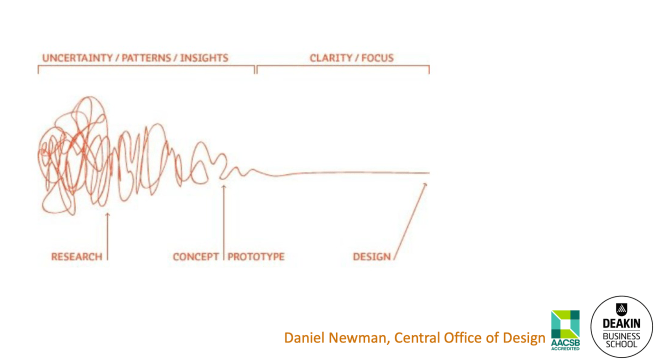The 10th session was the culmination of two weeks of learning about design thinking and applying the lessons to the wicked problem of increasing the number of refugees who access higher education. We presented our ideas to the rest of the class as well as the academic staff. But first there was a quick recap of the unit which I’ll reflect on first.
One of the first things that struck me, was the idea that design was a process. Yes we certainly followed an iterative process from empathising with our stakeholders through to testing our proto-types. I believe that the quicker and more often you can move through that process the more chance you have to come up with viable protypes and a chance to “fail fast” and dump less viable ideas while in prototype before investing in bringing a “bad idea” to fruition. This image also resonated with me. If you have been following this blog up to this point you will have noticed that in the early days of our group’s design process it really did look like the left. In fact if you have access to our Miroboard you can see that our early research was ideas slapped down on post it notes, quick thoughts crude sketches, we started with a wide and often zany net. Why not invade “Bad” countries, how about a one world government that’ll fix it. And then our early service model prototype, that while still chaotic began to see the roles, and components we would need to make our idea come into reality. Slowly we refined, clarified and focussed to get to our final service design, but importantly we did not jump straight to it, as this would have constrained our thinking and its likely if we had rushed to a solution we would have missed a lot of “good oil”

The next thing that really struck me, and I must say that I have to disagree with was the table below trying show some kind of hard dichotomous relationship between business and design. I found this slide sourced from Liedtka & Ogilvie (2011) even more jarring as a few slides down there was another slide headed “Everything in business is designed”

I think to be fair 2011 was a long time ago and business may have changed greatly since that time. I want to take some time to challenge the Liedtka & Ogilvie model here.
Let’s start with the underlaying assumptions we’ve got here…. “Reality of business is fixed and quantifiable” (???) Reality is constantly changing, businesses that fail to adapt will fall and falter. We saw this in 2020 in stark focus. Businesses that were able to pivot to continue to operate during pandemic lockdowns thrived, while others closed down or merely treaded water. Further the uncertainty of reality is widely acknowledged in business the A/NZ risk management standard is pretty clear about it when it talks about risk as “The effect of uncertainty on objectives”
Method…. Businesses use “Analysis aimed at providing one “best” answer, while design is “experimentation aimed at iterating toward a “better” answer. I think someone better tell Liedtka and Ogilvie that the 5 most valuable companies in the USA are highly experimental https://www.fxcm.com/markets/insights/10-largest-companies-in-the-us-by-market-capitalisation/ often release product before its perfect and iterate towards a better anwer as their customers use it, and actively improve it and tweak it based on customer feedback and analytics.
The next one really made me laugh. Business is about planning but design is about doing. Busineses go broke if they don’t “DO” they use things developed in the design or planning phase and use them to generate value for their stakeholders. I’ll mention tangentially though one of my mentors who died to young for this world vale Chris, when he managed software design projects I was on he would say almost ad nauseum “In the doing comes the knowing” this was to highlight that we get software out good enough to be used, get the users using it and iterate from there.
The decision drivers… nope not black and white either bother sides are needed in business and design, and as for values…… what the ? A business that does not innovate, and disrupt in today’s world will quickly shrink and die.
And here is the other slide I mentioned.

So like I said in one of my earlier blog entries on this unit design is in, and is everything. If it’s not you will fail. Link
Enough on that. The final presentation.
As I alluded to in a previous blog entry we presented our final service design using a story board / process model and some mocked up screen shots, and the main thing our unit chair Alex seemed to be interested in was economic viability and sustainability. I suppose after all is said and done, sometimes the old saying, “money talks and BS walks” holds true.
I thotoughly enjoyed this course and would recommend iit to anyone. Go in with an open mind and trust the process and you’ll be amazed by the results and the genuinely really cool ideas you’ll come up with. I’ll certainly have opportunities to apply design thinking in the workplace, though, much like in the group work itself it can be tough to get other people onboard and sometimes you are met with blank expressions of something far shy of enthusiasm, but take heart, keep up the energy and keep dreaming big.